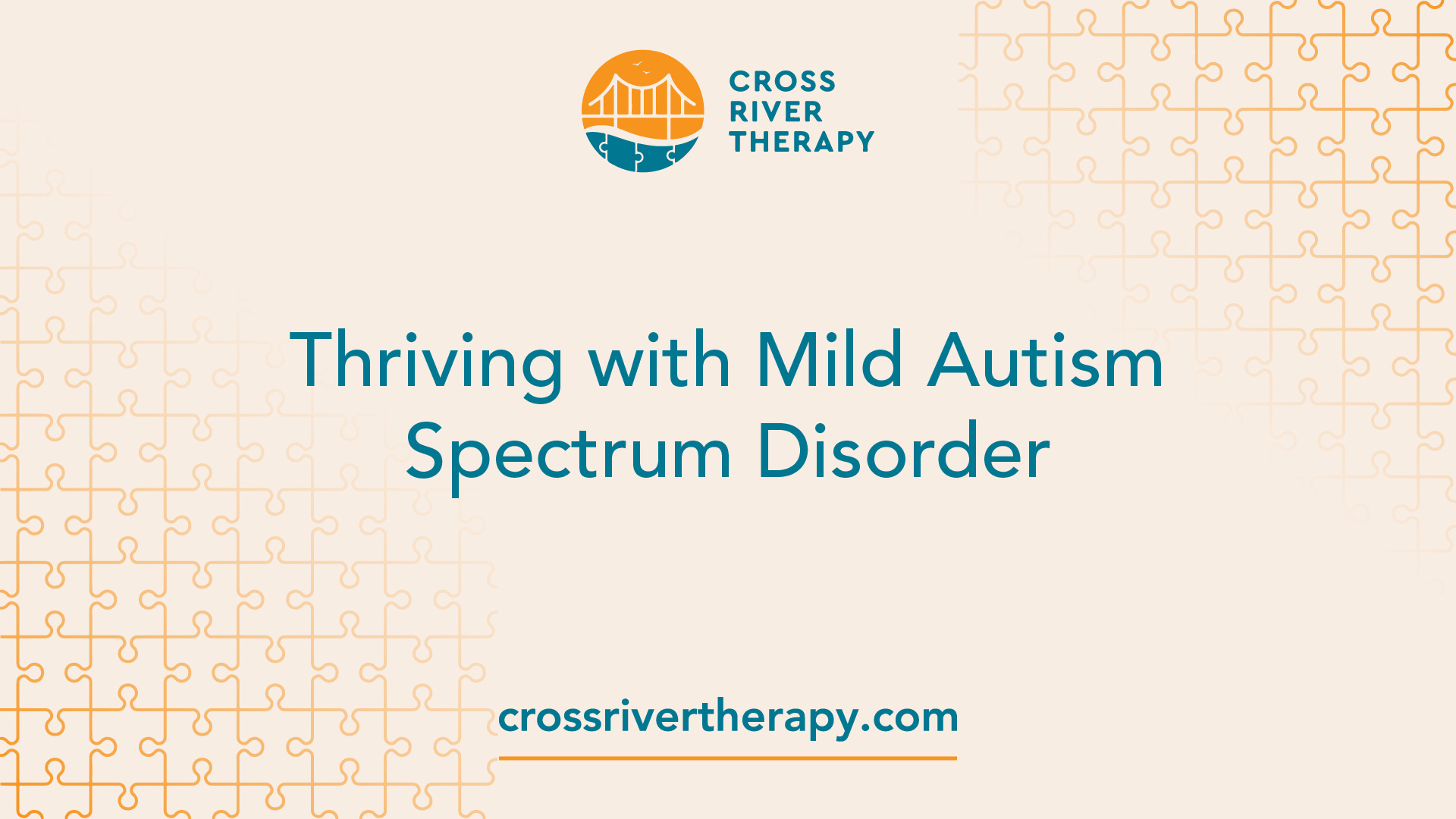Thriving with Mild Autism Spectrum Disorder
Discover effective strategies for thriving with mild autism spectrum disorder - empower potential!
Understanding Mild Autism Spectrum Disorder
Autism Spectrum Disorder (ASD) represents a wide range of neurodevelopmental conditions marked by varying degrees of social, communication, and behavioral challenges. The term "mild autism," although unofficial, is often used to describe individuals who fall into the Level 1 category of ASD, indicating that they have the lowest support needs.
Defining Mild Autism
"Mild autism," also informally referred to as "high-functioning autism," is used to denote Level 1 ASD. This terminology, however, is often seen as inaccurate and inappropriate as it fails to capture the daily struggles faced by individuals on the autism spectrum, regardless of their support needs.
The Diagnostic and Statistical Manual of Mental Disorders, 5th Edition (DSM-5), defines autism spectrum disorder based on levels of “severity,” with Level 1 typically classified as “mild” autism. Individuals with Level 1 autism are able to live independently and work, but they might seek individual therapy to cope with stress and any co-occurring diagnoses they might have [1].

Symptoms and Characteristics
Individuals with Level 1 autism may struggle with initiating and maintaining social interactions and may not seem as interested in these relationships as their neurotypical peers. They may adhere to very specific routines and face difficulties with transitions, organization, and planning.
Signs of autism in individuals with low support needs may include challenges with social interaction, understanding body language, reading social cues, and deciphering facial expressions. These individuals may exhibit advanced academic abilities, yet struggle with social skills, sensory challenges, or organization [2].
The signs and symptoms of ASD can vary widely and may appear at different stages of life. Some individuals may show signs within the first few months of life, while others may not display any noticeable signs until much later [3].
Moreover, individuals with mild autism often adopt coping skills to suppress these traits, making them less obvious, particularly in adults. Consequently, these individuals may not receive a diagnosis until adulthood, or in some cases, may never receive a formal diagnosis.
Understanding the characteristics and challenges of mild autism spectrum disorder can aid in early detection and intervention. It is important to note that each individual is unique and may not exhibit all of the commonly associated traits. Therefore, a comprehensive evaluation by a healthcare professional is vital to ensure an accurate diagnosis and the implementation of appropriate support strategies.
Diagnosis and Identification
Identifying and diagnosing mild autism spectrum disorder is a critical step towards understanding and managing the condition. The process involves distinct steps and can be influenced by various factors.
Diagnosis Process
Diagnosis of mild autism spectrum disorder involves detailed observations and a comprehensive information gathering process. There is no simple medical test for diagnosing autism. Instead, healthcare professionals rely on observations and information gathering to assess and reach a diagnosis.
Assessment is usually done by a team of specialists, such as child psychiatrists, psychologists, pediatric neurologists, or developmental pediatricians. They evaluate the individual's behavior, social interactions, and communication skills to determine whether they align with the diagnostic criteria outlined in the Diagnostic and Statistical Manual of Mental Disorders (DSM-5).
The DSM-5 is a widely recognized diagnostic tool used to evaluate and diagnose autism. This comprehensive assessment helps professionals determine the appropriate support needed for the individual.
Late Diagnosis Factors
Diagnosing mild autism spectrum disorder can sometimes be challenging due to the wide variation in symptoms and their severity. Some individuals with mild autism may not exhibit the more recognizable symptoms of the disorder, leading to a potential delay in diagnosis.
Furthermore, societal and cultural perceptions of 'normal' behavior can also play a role in delayed diagnosis. In some cases, a child's behavior may be attributed to their personality traits or dismissed as a phase they will outgrow, delaying the identification of potential symptoms of autism.
The lack of a specific medical test for autism also contributes to potential delays in diagnosis. The reliance on behavioral observations and assessments means that the diagnosis often depends on the expertise and experience of the healthcare professionals involved.
Understanding these factors can help in advocating for early screening and intervention, leading to better outcomes for individuals diagnosed with mild autism spectrum disorder.
Treatment Approaches for Mild Autism
When it comes to managing mild autism spectrum disorder, a variety of treatment approaches can be utilized. These often include behavioral approaches, developmental approaches, educational treatments, pharmacological approaches, and psychological approaches.

Behavioral Approaches
Behavioral approaches, particularly Applied Behavior Analysis (ABA), are widely accepted methods of treating symptoms of Autism Spectrum Disorder (ASD). ABA programs help individuals with ASD to develop socially acceptable behaviors by reinforcing positive behaviors and reducing negative ones. The progress in ABA is tracked and measured, making it a notable treatment for individuals with ASD [5].
Developmental Approaches
Developmental approaches, such as Speech and Language Therapy and Occupational Therapy, are commonly employed therapies for individuals with ASD. Speech and Language Therapy aims to improve the person's understanding and use of speech and language, while Occupational Therapy teaches skills for independent living. Both therapies target the development of essential skills and abilities, helping those with mild autism spectrum disorder integrate better into their environments [5].
Educational Treatments
Educational treatments, like the Treatment and Education of Autistic and Related Communication-Handicapped Children (TEACCH) approach, are provided in classroom settings. TEACCH focuses on consistency and visual learning methods to enhance academic and other outcomes for individuals with autism. This educational treatment is designed around the unique learning needs of those on the spectrum, promoting engagement and understanding of different concepts [5].
Pharmacological Approaches
Pharmacological approaches are used to treat co-occurring symptoms of ASD that could help individuals function better. Medication might target high energy levels, attention issues, self-harming behaviors, or co-occurring psychological conditions like anxiety or depression. It's crucial to note that any medication should only be administered under the guidance of a healthcare professional, with regular monitoring to ensure effectiveness and safety.
Psychological Approaches
Psychological approaches, such as Cognitive-Behavior Therapy (CBT), can assist individuals with ASD in dealing with mental health issues like anxiety and depression. CBT focuses on understanding the connections between thoughts, feelings, and behaviors to help individuals change how they react to situations. This approach is particularly effective in helping those with ASD to develop coping mechanisms and strategies for managing their emotions.
In conclusion, a variety of approaches can be utilized for treating mild autism spectrum disorder. The choice of approach will depend on the individual's unique needs and circumstances. With the right support and interventions, individuals with ASD can thrive and reach their full potential.
The Role of Family Members
Family members play an integral role in the lives of individuals with mild autism spectrum disorder. Their roles span across many aspects, from advocacy and support to planning for the future.
Advocacy and Support
One of the most critical roles family members play in the lives of their loved ones with autism is that of an advocate. Parents, siblings, and other caregivers are often the best advocates for children and adults with autism, providing support and guidance throughout their lives [6].
Organizations like Autism Speaks are committed to promoting lifelong supports for people with autism, offering resources like the Advocacy Tool Kit. This tool kit equips family members with basic information about advocacy skills, ways to apply these skills in different situations, and information on advocacy at school and in the community. It also emphasizes the importance of teaching self-advocacy skills to individuals with autism.
Family members and friends of individuals with autism can access personalized support through the Autism Response Team (ART). This team is specially trained to connect people with autism, their families, and caretakers to information, tools, and resources.
Recognizing the importance of a supportive community around individuals with autism, Autism Speaks also developed a Friend's Guide to Autism. This guide provides an overview of autism, insights into what the friend might be feeling, and guidance on how to support the friend, their child, and the entire family.
Planning for the Future
Children with mild autism spectrum disorder will need some level of support throughout their life. It's essential to plan for their future opportunities, such as employment, college, living situation, independence, and necessary support services.
Parents often seek alternative or complementary therapies for autism spectrum disorder. However, many of these treatments lack scientific evidence of effectiveness and could potentially reinforce negative behaviors or be dangerous. It's advised to discuss these therapies with the child's doctor before implementing them [4].
Raising a child with mild autism spectrum disorder can be physically exhausting and emotionally draining. It's important for caregivers to seek support and care for their well-being as well. Suggestions to cope with the challenges include seeking help, building a support network, educating yourself about autism, and taking breaks when needed.
The role of family members is pivotal in the journey of individuals with mild autism spectrum disorder. From providing daily support and advocacy to planning for the future, their involvement can significantly impact the individuals' life quality and potential.
Living with Mild Autism
Living with mild autism spectrum disorder requires understanding, adaptability, and structure. Crucial to this are maintaining a consistent daily routine and adjusting to the individual's specific needs.
Daily Routine and Structure
For those living with mild autism spectrum disorder, maintaining a regular routine is critical. An example from Quora outlines the daily routine of an individual on the autism spectrum. This routine includes set activities such as watching trains, going for walks, helping with household chores, and engaging in leisure activities like watching YouTube or playing video games. Regular meal times and bedtimes also contribute to a sense of stability.
Variations in the routine can cause emotional distress, highlighting the significance of consistency and predictability for those on the autism spectrum.
Adapting to Individual Needs
Adapting to individual needs is another crucial aspect of living with mild autism. For example, an individual may have specific fears or challenges that necessitate adjustments in their environment. As described on Quora, one individual was terrified of the stove due to a past incident. To support his independence in meal preparation, his diet was adjusted to include microwavable or toaster-oven convenience meals.
In another case, a son was withdrawn from a public school special-needs program as it was not adequately meeting his needs. His mother then provided one-on-one support, which significantly benefitted him. This example illustrates the need for individualized support and adaptations based on the unique needs and challenges of those on the autism spectrum.
Ultimately, living with mild autism spectrum disorder involves continual adaptation and structure. By understanding the unique needs of those on the spectrum and providing a supportive and stable environment, individuals with mild autism can continue to learn, grow, and thrive.
References
[1]: https://www.verywellmind.com/mild-autism-definition-traits-treatment-5226088
[2]: https://www.verywellhealth.com/what-is-mild-autism-260244
[3]: https://www.canada.ca/en/public-health/services/diseases/autism-spectrum-disorder-asd/signs-symptoms-autism-spectrum-disorder-asd.html
[4]: https://www.mayoclinic.org/diseases-conditions/autism-spectrum-disorder/diagnosis-treatment/drc-20352934
[5]: https://www.cdc.gov/ncbddd/autism/treatment.html
[6]: https://www.autismspeaks.org/autism-support-family-help



